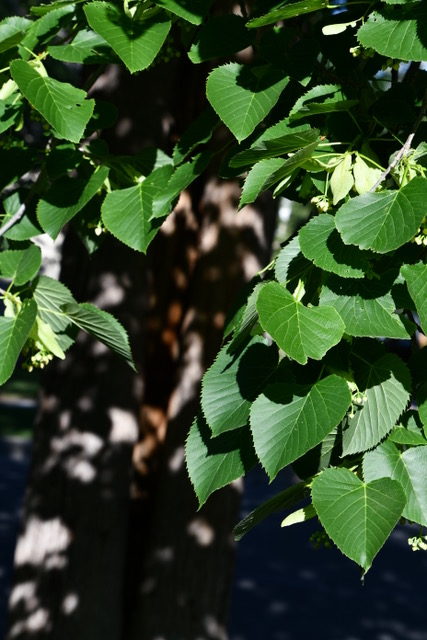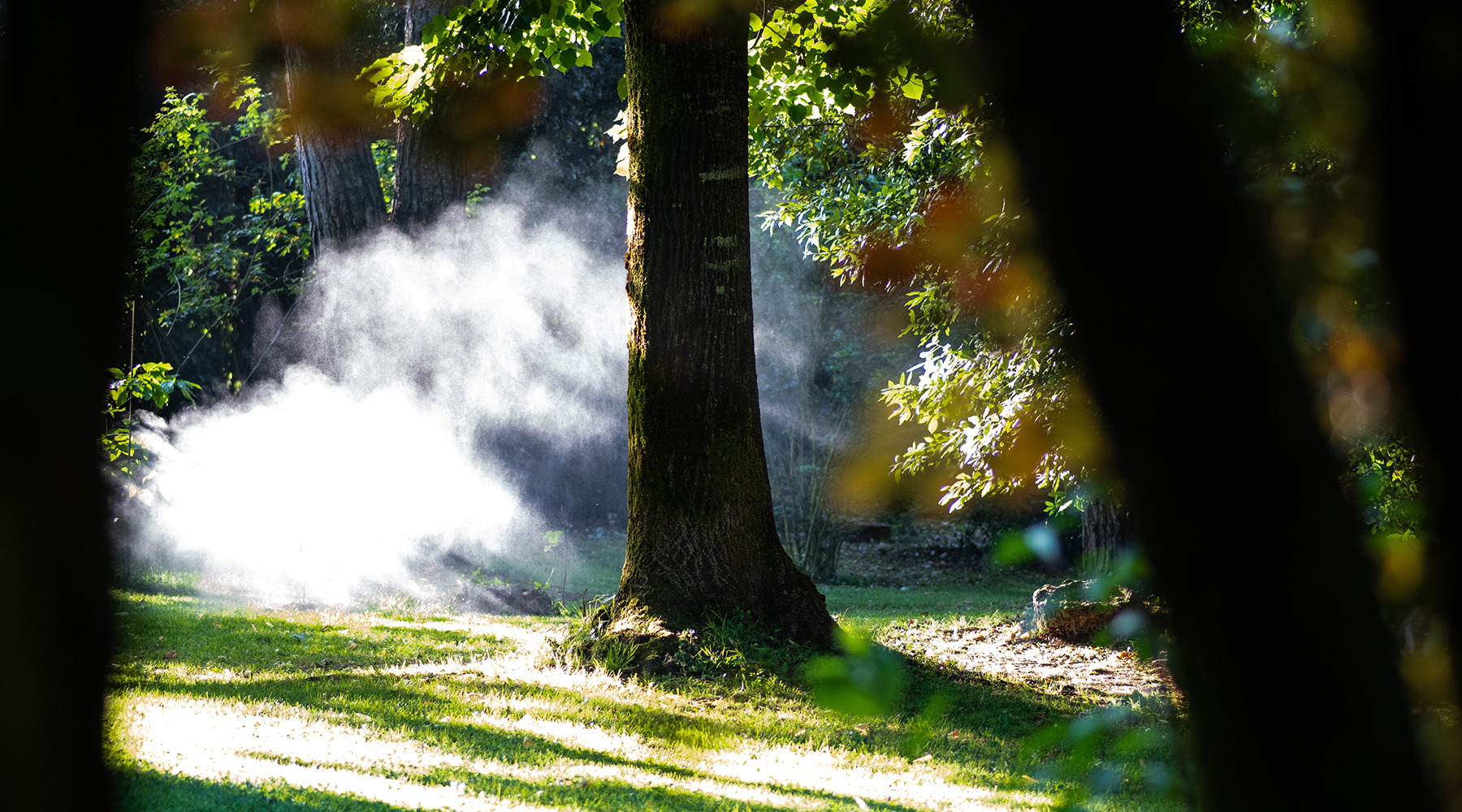It is in the summer that the pair of trees call out to me. They have always been there since the day we moved in, standing in the front yard tall and quiet, their presence a kind of constant grace over my house, despite the fact that I have taken so little notice of them in 24 years. For just a few weeks in the month of July they are in bloom, with pendulous tiny ivory blossoms hanging under the large heart-shaped leaves. And the scent! The floral perfume is as sweet as honeysuckle and almost intoxicating on a hot July evening. It caught us by surprise that first summer, because the fragrance overwhelms a person only in the evening, as the sunset appears. Brought out by the warmth of the sun and the long days of summer, the beautiful sweetness only lasts for a few short weeks. Sitting on the front porch enjoying this perfume as the pink and orange clouds slowly move through the sky is a memory of summer at my house, along with watching the angular shapes of bats darting in and out of the trees, catching bugs as the night slowly envelopes us.
I really had enough to do when we bought the house, as a young mother busy with three children and a fourth to come along soon. It was enough to appreciate that the front yard was shaded in summer by the big leafy branches arching over us. Every autumn the same branches would release their leaves to float down into crisp, crinkly, brown piles that the kids spent hours raking and jumping in again and again, now with a scent something like oolong tea. One of the trunks had been struck by lightning before we moved in, and that tree still has a streak of bare wood stretching from the top down to the ground. The squirrels have found a little hole in this part of the trunk, an ideal place for nesting and raising their babies. Yes, this dyad of stately trees has bestowed upon my house and its inhabitants gratuitous blessings year after year, gifts which I hardly found the time to notice, much less voice my thanks to the Giver of all such beautiful gifts.
Until this year. With the children now grown into adulthood, and the house quiet about me, in the early spring I stopped as I walked from the street to the front door. The familiar heart-shaped leaves were just beginning to show themselves, tiny green signs of life emerging from the brown twigs of winter. What variety of tree are these twins, anyway, I wondered? I can recognize an oak or a maple readily enough, but these are unlike any others in my neighborhood. I was sure they had a name, but I didn’t know what it was. How does one find the name, the variety, the species of a tree? The search took me first to the trees themselves, noticing things I had taken for granted — the shape and size of the leaves, the height and thickness of the trunk, the arch and sway of the branches. Once I had all of this in mind it was embarrassing just how easy it was to identify my trees.

For a much longer time I have been on another kind of search, a search more knotty and tangled. It is the search for my own name, the name God has given me. I find it so easy to listen to other naming voices, or to forget who I am called to be. I wondered — what would it look like to live as though I know myself more fully, to understand my deepest longings, to know my strengths and to give myself grace for my limitations? Though I have walked through helping my children find their talents, interests, and strengths, I am still asking these questions myself. I need the reminder of these audacious words:
“But now thus says the Lord, he who created you, O Jacob, he who formed you, O Israel: ‘Fear not, for I have redeemed you; I have called you by name, you are mine.’” ~ Isaiah 43:1, ESV
The One who formed and created me knows my name, and the story that I am now living began with His vision of who I would be. To be means to have an identity, to be known, to be named and loved by my Lord and Creator. To belong, to be His. He knows me even though I don’t fully know myself. The fact is, the more I seek to know myself, the more I come to know the God who made me. Augustine of Hippo wrote about this in his Confessions. In his famous prayer, “O God, let me know myself; let me know you,” he reveals that the eventual discovery of God begins with a discovery of one’s self. The more I think about this the more I realize that the day when I will have knowledge of both myself and God will be when I see Him face to face. St. Augustine says this:
Let me know you, O you who know me; then shall I know even as I am known. You are the strength of my soul; make your way in and shape it to yourself, that it may be yours to have and to hold, free from stain or wrinkle. (Confessions, Book X, Chapter 1)
Let me, then, confess what I know about myself, and confess too what I do not know, because what I know of myself I know only because you shed light on me, and what I do not know I shall remain ignorant about until my darkness becomes like bright noon before your face. (Confessions, Book X, Chapter 5)
Paul says it this way: “For now we see in a mirror dimly, but then face to face. Now I know in part, then I shall know fully, even as I have been fully known.” ~ I Corinthians 13:12, ESV
Then I shall know. I shall know myself even as I have been fully known. This thought contains a truth that is deeper and wider than an entire forest of trees — I have been known, fully.
“Oh Lord, you have searched me and known me!
You know when I sit down and when I rise up;
you discern my thoughts from afar.
You search out my path and my lying down
and are acquainted with all my ways.
Even before a word is on my tongue,
behold, O Lord, you know it altogether.
You hem me in, behind and before,
and lay your hand upon me.
Such knowledge is too wonderful for me;
it is high; I cannot attain it.
Psalm 139:1-6, ESV
Even as the name, the identity of my trees were unknown to me, they were always known to God, the Creator who made them and gave them the unique qualities I see out my window. They have been faithfully living out that identity each year, their leaves and blossoms reaching out to be what they were always meant to be, and so glorifying the Creator by giving back to Him what He has made.

A month ago I had the opportunity to take a trip to Paris, and while there decided to walk around a beautiful garden, the Jardin des Tuileries which is just adjacent to the Louvre. Ambling along the pathways, I suddenly noticed a beautiful scent wafting through the air. I looked up to see that the entire garden was lined with trees, my trees, the trees with heart-shaped leaves and tiny ivory pendulous blossoms. Hundreds of linden trees. Yes, linden — the tree known as ‘tilia’ in France, ‘lindenbaum’ in Germany, the lime tree in England. It is the linden tree that is included in Aragorn’s Song of Lúthien and Beren, and also in the Canterbury Tales. Herodotus, Homer, Horace, Virgil, and Pliny all mention the linden tree and its virtues, and Ovid tells the old story of Baucis and Philemon: she was changed into a linden and he into an oak when the time came for them both to die. Since the 12th and 13th centuries poets have used the lindenbaum in German lyric poetry as the spot for a lover’s rendezvous and hence, a symbol of all that is gentle, sweet (lind) and good in nature. One of these poems (Der Lindenbaum) by Wilhelm Müller was set to music by Schubert in 1827, the entire cycle being probably the most famous song cycle in all of music — Winterreise. I also found out that the flowers of the linden tree make an excellent tea (tilleul) with a soothing, calming effect. And the wood — the wood was especially favored by Renaissance craftsmen who used the finely grained material for intricate carvings, including countless ornaments found in the quire at St. Paul’s Cathedral and the cherubs gracing Trinity College Chapel in Oxford.
By discovering the name of my trees, suddenly a whole world has opened up to me! I see them everywhere now, and smile when I smell their lovely blossoms or feel the cool shade of their branches. Their identity sings of the Creator who made them for a beautiful purpose. He has always known their name, and mine too.
![]()
Featured image is courtesy of Bruce Kee via Unsplash; photographs are courtesy of Steve Moon. We are grateful for their generosity.
Terri Moon is a musician and a lover of Jesus. She delights in playing the music of Bach, growing English roses, baking up a good batch of scones, and all good, true, and beautiful things that point to Him. She has found that the most fulfilling adventures come through collaborating with others, and to that end she and her husband Steve (also a member of The Cultivating Project) serve gladly in their church and also on the leadership team of the Anselm Society. Together they raised four children and are now proud grandparents. Hosting friends in their Colorado home is one of their favorite joint adventures.
Terri holds a master’s degree in violin performance, and has collaborated in many concerts and taught students of all ages for 40 years. Her lifelong passion is the intersection of music, worship, and spiritual formation, and she longs to bring to life the beauty of the Church’s heritage in the arts. Terri currently serves as the Music Director of Holy Trinity Anglican Church in Colorado Springs.
Leave a Reply
A Field Guide to Cultivating ~ Essentials to Cultivating a Whole Life, Rooted in Christ, and Flourishing in Fellowship
Enjoy our gift to you as our Welcome to Cultivating! Discover the purpose of The Cultivating Project, and how you might find a "What, you too?" experience here with this fellowship of makers!


What a beautiful essay! My soul delighted in learning more about your trees and your faith journey.
Thank you so much, Tonda! I’m so happy that you took the time to read this, and I hope it encourages you! He knows your name too.
A beautiful exploration and reflection, Terri! Your two closing sentences remind that we are His song that He delights to sing. So glad you heeded His song sung by your two ‘sweet’ trees!
Denise
What a rich and beautiful essay. So lovely, Terri!!
Beautifully said, Terri Moon, that God knows our names.
Thank you Terri for these beautifully written words. A joy to meet you in England with C.S. Lewis Foundation the end of July in 2022 I believe. Looking forward to the Writer’s conference in early May 2024 at Glen Eyrie.